The 2020 Mac Mini Unleashed: Putting Apple Silicon M1 To The Test
by Andrei Frumusanu on November 17, 2020 9:00 AM ESTBenchmarks: Whatever Is Available
As we’ve had very little time with the Mac mini, and the fact that this not only is a macOS system, but a new Arm64-based macOS system, our usual benchmark choices that we tend to use aren’t really available to us. We’ve made due with a assortment of available tests at the time of the launch to give us a rough idea of the performance:

One particular benchmark that sees the first light of day on macOS as well as Apple Silicon is Cinebench. In this first-time view of the popular Cinema4D based benchmark, we see the Apple M1 toe-to-toe with the best-performing x86 CPUs on the market, vastly outperforming past Apple iterations of Intel silicon. The M1 here loses out to Zen3 and Tiger Lake CPUs, which still seem to have an advantage, although we’re not sure of the microarchitectural characteristics of the new benchmark.
What’s notable is the performance of the Rosetta2 run of the benchmark when in x86 mode, which is not only able to keep up with past Mac iterations but still also beat them.
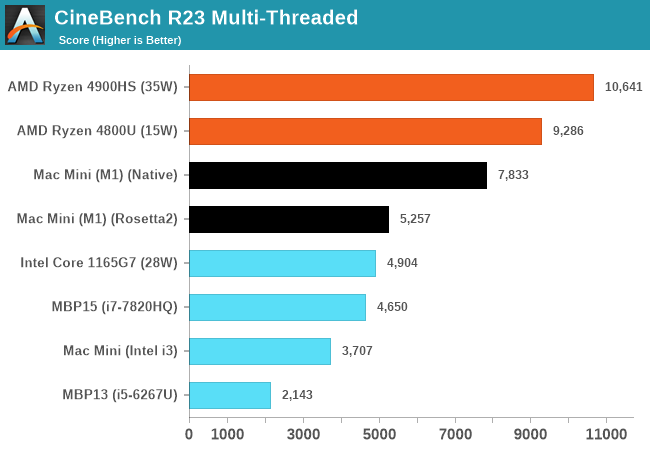
In the multi-threaded R23 runs, the M1 absolutely dominates past Macs with similar low-power CPUs. Just as of note, we’re trying to gather more data on other systems as we have access to them, and expand the graph in further updates of the article past publishing.
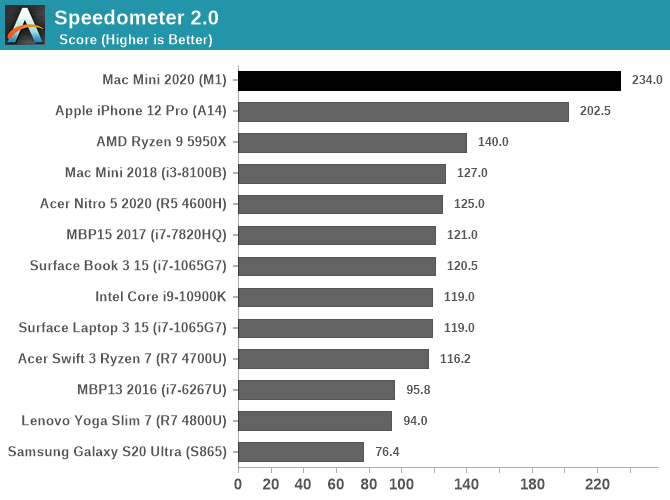
In browser-benchmarks we’ve known Apple’s CPUs to very much dominate across the landscape, but there were doubts as to whether this was due to the CPUs themselves in the iPhone or rather just the browsers and browser engines. Now running on macOS and desktop Safari, being able to compare data to other Intel Mac systems, we can come to the conclusion that the performance advantage is due to Apple’s CPU designs.
Web-browsing performance seems to be an extremely high priority for Apple’s CPU, and this makes sense as it’s the killer workload for mobile SoCs and the workload that one uses the most in everyday life.
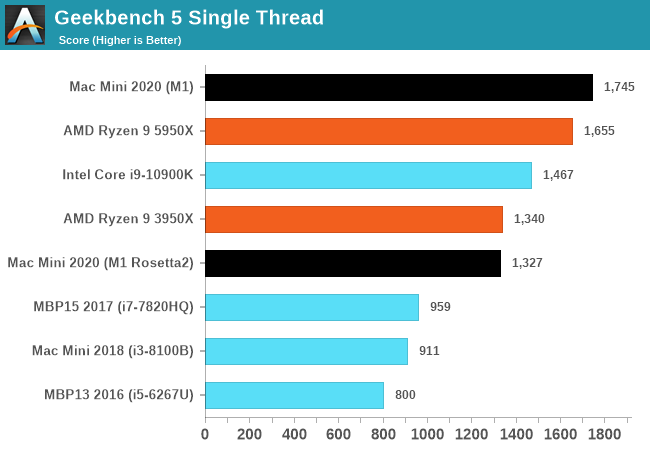
In Geekbench 5, the M1 does again extremely well as it actually takes the lead in our performance figures. Even when running in x86 compatibility mode, the M1 is able to match the top single-threaded performance of last generation’s high-end CPUs, and vastly exceed that of past iterations of the Mac mini and past Macbooks.
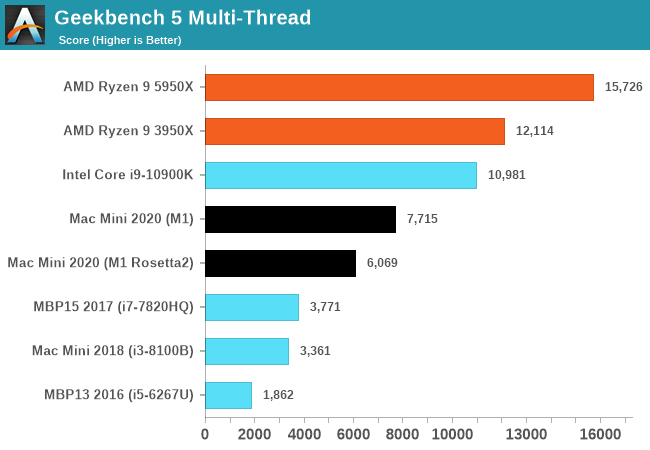
Multi-threaded performance is a matter of core-count and power efficiency of a design. The M1 here demolishes a 2017 15-inch Macbook Pro with an Intel i7-7820HQ with 4 cores and 8 threads, posting over double the score. We’ll be adding more data-points as we collect them.


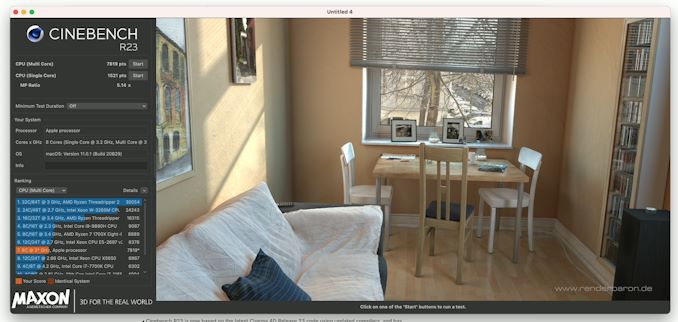








682 Comments
View All Comments
demofly - Tuesday, November 17, 2020 - link
I wish there were more benchmarks besides Geekbench and Cinebench. They are unreliable in comparing processors of the same ISA, let alone completely different ISAs.morgenrot - Tuesday, November 17, 2020 - link
Well, there's compiler performance, where the M1 outdoes an 8-core i7 both in speed: https://techcrunch.com/wp-content/uploads/2020/11/... and in energy efficiency: https://techcrunch.com/wp-content/uploads/2020/11/...I think this is great, it puts the fairytale to bed that ARM processors are only good for iPads or cell phones and couldn't possibly compete with "real" processors (i.e. x86) (of course, that's what people said in the '90ies about x86, lol). It also adds extra spice to the amazing resurgence of AMD, and puts extra fire under Intel's butt to get its act together. Hopefully Intel comes back and produces the successor of Tiger Lake at below 10 nm, and when Zen 4 comes out on 5 nm on AM5 with DDR5 and Apple adds more memory channels and DDR5 to its desktop processors, this is all going to get quite exciting. Watching processor tech hasn't been this much fun in a long time! Now I gotta go and get more popcorn.
Farfolomew - Tuesday, November 17, 2020 - link
I'm curious how much the man, the myth, the legend, Anand La Shimpi, has had a hand in developing/architecting Apple's custom silicon, up to, and including, this M1. Would be cool to hear an update from him :-). This is a major moment in CPU history.Tomatotech - Tuesday, November 17, 2020 - link
Most likely none. The Ax series were well advanced before Anand joined Apple. Also remember that Anand was a journalist here, not a computer science developer. I'm sure he's doing good work at Apple though. If I take a wild guess, he's possibly working in some sort of communications capability, translating between the people who write reports / press releases, and the wild-haired uber-nerds who only speak binary. That kind of role would use the skills he built at Anandtech - understanding technical content and making it accessible to non-technical people.realbabilu - Tuesday, November 17, 2020 - link
Great.Apple can control all software hardware for optimization. The result is amazing.
But please don't sluggish it deliberately old Mac so customers want to buy a new one like iphone.
The gpu iis crazy here,please more mac games developed, not like intel mac. Also more cad and cae, this small M1 needs killer application
Farfolomew - Tuesday, November 17, 2020 - link
I don't think it will happen, but imagine if you could Bootcamp these new Macbooks and install Windows? If they ran translated x86-64 at 66% performance vs that of native AArch64 (based on Rosetta2 results), the hardware alone would be some of the best PC Laptop/Ultrabook hardware we've ever seen, with massive battery improvements and low TDP.Just a thought
Makste - Wednesday, November 18, 2020 - link
I like itzodiacfml - Tuesday, November 17, 2020 - link
Thanks Anandtech. What do you think is the power required to run the integrated RAM? Is the M1 in the Mini a 15W TDP chip? If it is then Apple's work here is on par with Intel's and AMD's current gen.One thing left out though is Apple's more powerful part for larger products. I think they will have a 16 core CPU and 16 core discrete GPU
Ryan Smith - Tuesday, November 17, 2020 - link
"Thanks Anandtech. What do you think is the power required to run the integrated RAM?"It looks to top out at around 1.6 Watts, judging from some additional power info we've been able to collect this afternoon.
zodiacfml - Wednesday, November 18, 2020 - link
Nice. Thanks!